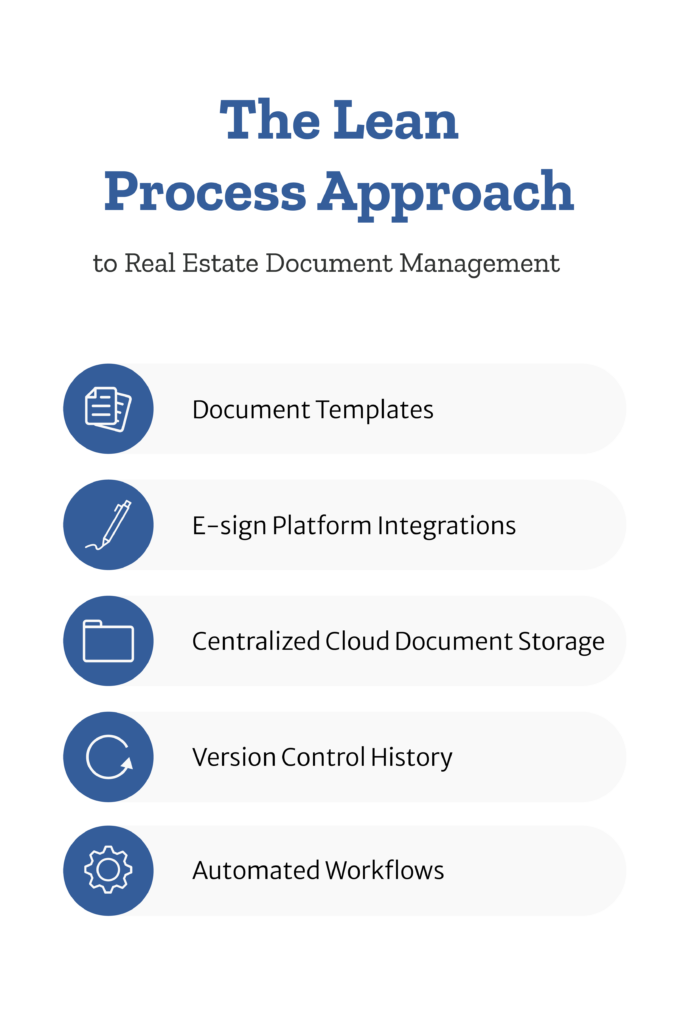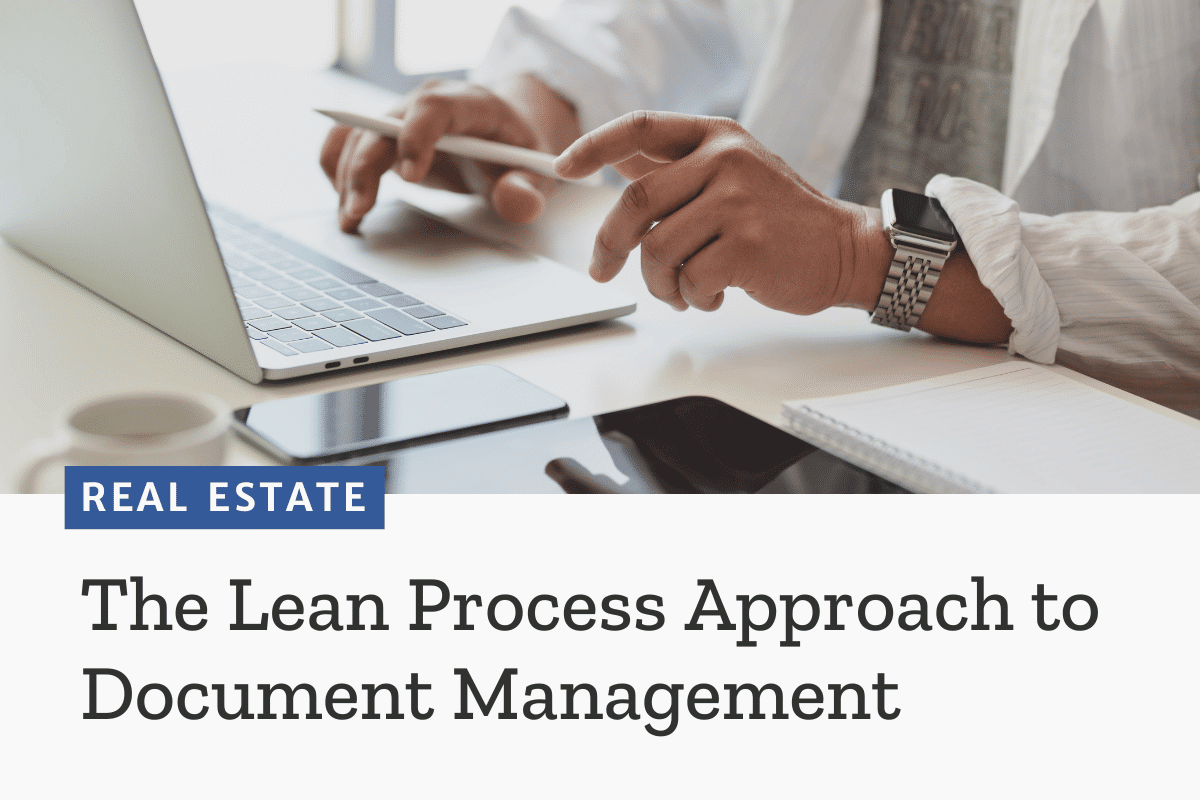From listing agreements to closing disclosures, the sheer volume of documents TCs manage can be overwhelming, making efficiency a critical component of success. Enter the lean process approach to document management—a game-changer specifically tailored for the real estate industry. Borrowed from manufacturing principles and adapted for the digital age, this methodology is revolutionizing how TCs and agents manage the paper trail, transforming the chaos of traditional paperwork into a streamlined, efficient process that keeps transactions moving smoothly.
Understanding Lean Process in Real Estate
At its core, the lean process was originally developed by Toyota for car manufacturing and focuses on maximizing value while minimizing waste. In real estate, this means efficient document handling by eliminating unnecessary steps and emphasizing activities that add value to transactions. Lean principles have been successfully applied in various industries, and their relevance in real estate is growing. You can read more about the lean methodology in manufacturing here.
Key Principles of Lean Document Management
- Value Identification: Prioritize activities that clients value.
- Document Flow Mapping: Chart the document journey from listing to closing.
- Smooth Flow: Ensure documents move seamlessly through stages.
- Demand-Driven Processing: Create and process documents based on demand.
- Continuous Improvement: Regularly refine document management processes.
Implementing Lean Document Management

Streamlining Document Creation
Start by streamlining document creation with standardized templates for common documents like listing agreements and purchase offers. A digital library of templates ensures consistency and reduces errors. Sites like eforms can help source these for free based on the state you’re in.
Digital Signatures
Integrate digital signature platforms such as DocuSign or Adobe Sign to expedite signing processes significantly, reducing delays from days to hours. Digital signatures not only save time but also enhance security and compliance, which are crucial in real estate transactions.
Centralized Document Storage
Centralize document storage using cloud-based solutions like Dropbox or Google Drive for easy access and collaboration among TCs, agents, and clients. Specialized real estate transaction management software, such as SkySlope, Dotloop or ListedKit can also serve as a central hub for all transaction documents, offering features tailored specifically for the real estate industry.
Version Control
Version control is often overlooked but is vital in real estate transactions where documents frequently go through multiple revisions. A lean approach to version control ensures that everyone is always working from the most up-to-date version of a document, reducing confusion and potential legal issues. Implementing a check-out/check-in system for document editing and maintaining a log of all changes made to key documents can be achieved using tools like Microsoft SharePoint or Google Workspace.
Data Analytics for Continuous Improvement
To truly embrace the lean philosophy, it’s essential to leverage data analytics for continuous improvement. By tracking metrics related to your document management process, you can identify bottlenecks, streamline workflows, and make data-driven decisions to improve efficiency. Key metrics might include time from document creation to final signature, number of revision cycles per document, frequency of errors or omissions in documents, and client satisfaction scores related to paperwork handling.
Automating Workflows
Automation is a cornerstone of lean document management. By setting up automated workflows, you can ensure that documents are routed to the right people at the right time, with automatic notifications to keep everyone in the loop. Tools like Zapier or Microsoft Power Automate can help create automated workflows that integrate various applications used in real estate transactions.
For example, when a listing agreement is signed, it can automatically notify the marketing team to begin property promotion. When an offer is accepted, it can trigger notifications to the lender, title company, and inspector. When an inspection is completed, it can alert the buyer’s agent to review and discuss results with clients.
Advantages of Lean Document Management
The advantages of adopting a lean process approach in real estate document management are manifold. Firstly, it drastically reduces the time spent on administrative tasks, freeing up agents and TCs to focus on client interactions and closing deals. By automating repetitive tasks and utilizing digital tools, you minimize human error and enhance accuracy in document handling.
Moreover, a lean approach leads to cost savings. Less time spent on document management means lower labor costs, and transitioning to a paperless office reduces expenses related to printing, storage, and supplies. The environmental benefits of going paperless also resonate well with clients who value sustainability.
Overcoming Common Challenges
While implementing lean document management offers numerous benefits, it’s not without its challenges. Resistance to change is a common hurdle, as is the learning curve associated with new technology. To overcome these obstacles, involve your team in process improvement discussions from the outset. Providing comprehensive training and support ensures everyone is comfortable with new systems and processes.
Gradual implementation can also ease the transition. Start with a few key processes, refine them, and then expand to other areas. This phased approach allows for adjustments based on feedback and reduces the risk of overwhelming your team. Robust security measures are essential to address data security concerns. Ensure your digital tools and cloud storage solutions are secure and compliant with industry standards to protect sensitive client information. You can learn more about data security in real estate from this article.
Integration with Other Systems
A lean document management process doesn’t exist in isolation. It should seamlessly integrate with other systems used in your real estate business, such as CRM software, accounting systems, and marketing tools. This integration reduces data entry and associated errors, improves data consistency across systems, and enhances reporting capabilities. For instance, integrating with CRM systems like Salesforce or HubSpot can streamline client communication and document management.
Case Studies and Real-World Applications
Real-world examples illustrate the tangible benefits of lean document management. For instance, a TC in California implemented digital signatures and reduced the average time to get all signatures on a purchase agreement from three days to just four hours. Another real estate agency leveraged cloud-based storage and saw a 30% reduction in document retrieval times, significantly speeding up transaction cycles.
A case study published by NAR highlights a real estate firm that adopted lean document management practices and saw a 40% reduction in administrative costs within the first year. The firm utilized a combination of digital signatures, automated workflows, and cloud storage to achieve these results.
Future of Lean Document Management
As technology evolves, so too will the possibilities for lean document management in real estate. Artificial Intelligence (AI) and Machine Learning can automate document classification, extract key information, and flag potential issues in contracts. AI tools like Kira Systems are already being used in legal document management to enhance accuracy and efficiency. For real estate, tools like ListedKit can extract details from contracts using AI in seconds. Blockchain technology can provide an immutable record of document history, enhancing security and trust in the transaction process. Augmented Reality (AR) could allow for more intuitive ways to review and sign documents, making the process more engaging for clients. More sophisticated analytics tools will provide deeper insights into document workflows, enabling even greater efficiencies. For more on future technologies, see this article.
Conclusion
In an industry where time and accuracy are critical, lean document management isn’t just beneficial—it’s essential. By streamlining processes, you not only ease your workload but also elevate client experience. Remember, embracing lean is a journey of continuous improvement. Start now, and reap the rewards of efficiency, accuracy, and client satisfaction in every transaction. Adopting lean processes is not just about immediate gains but about positioning your business for long-term success and adaptability in an ever-evolving real estate market.
Are you ready to go lean and mean with your document management?
Check out ListedKit–your future self (and your clients) will thank you for it!




